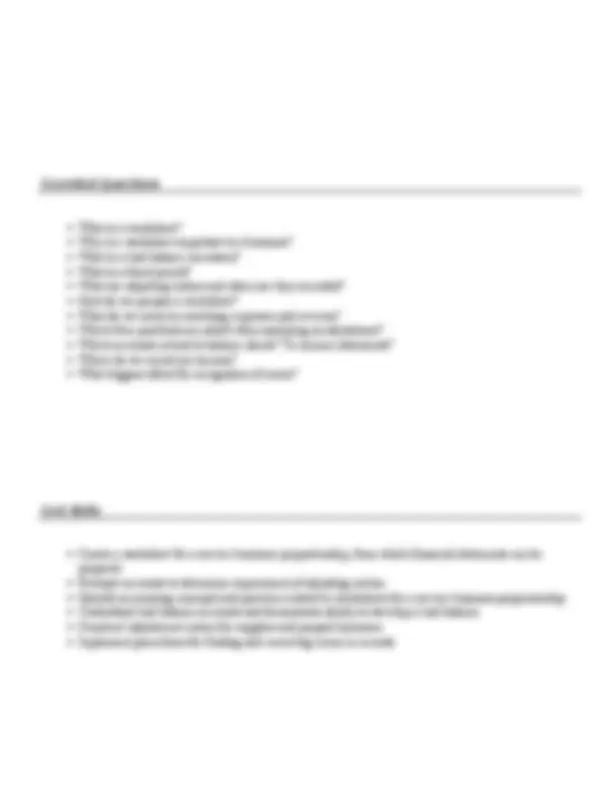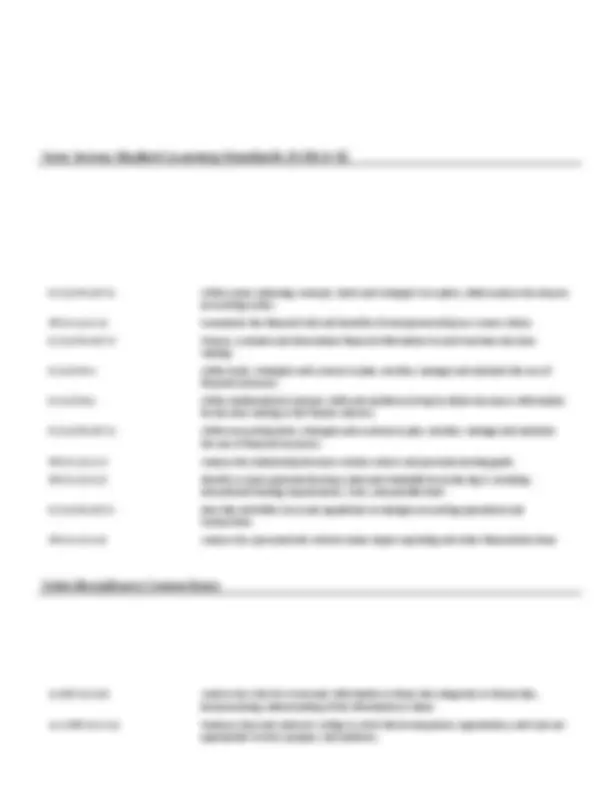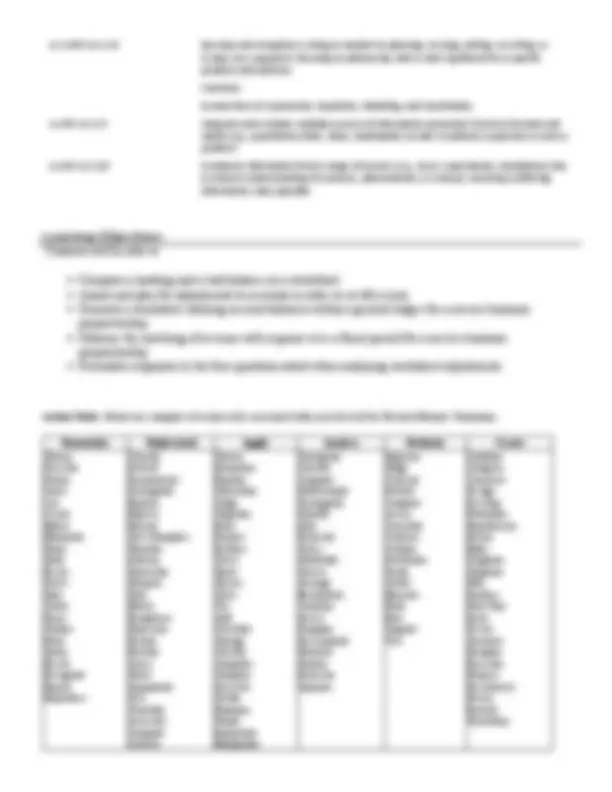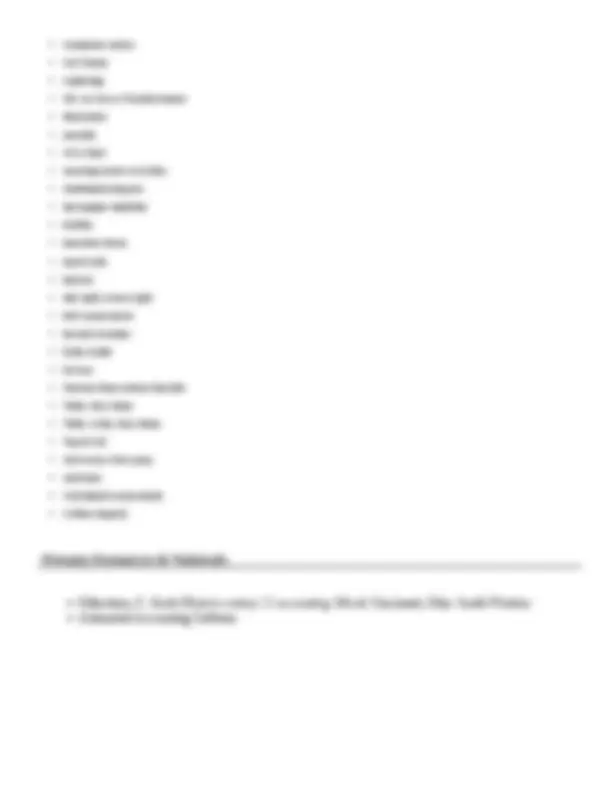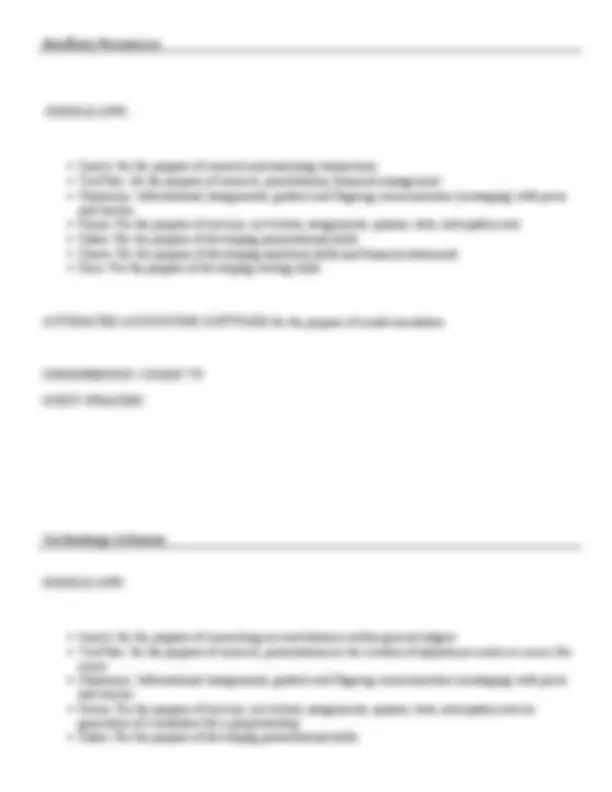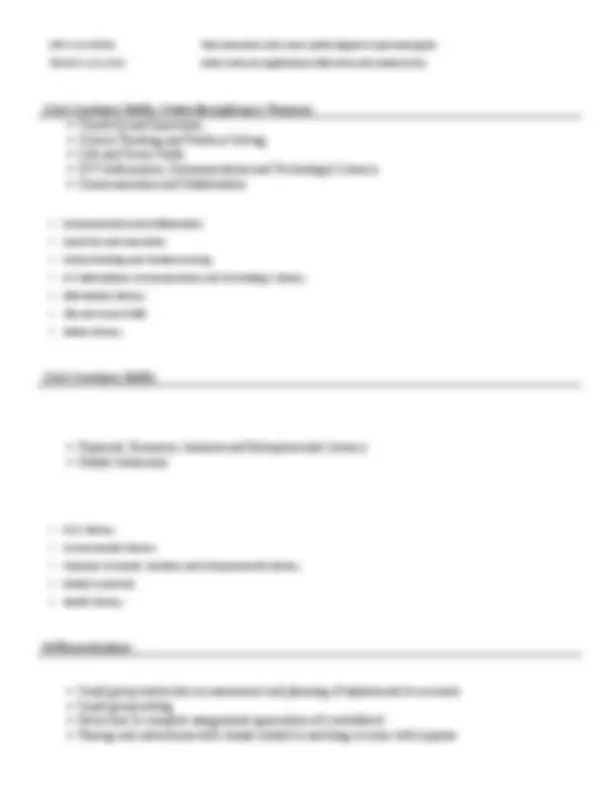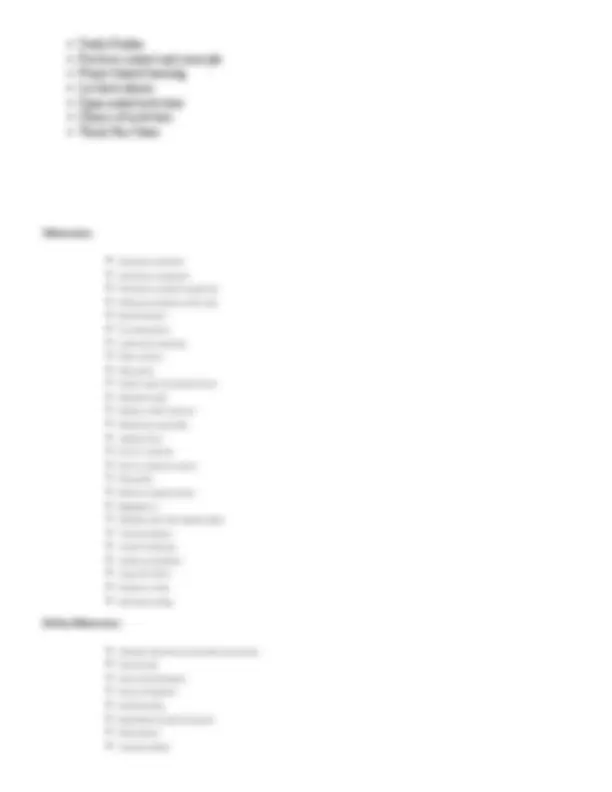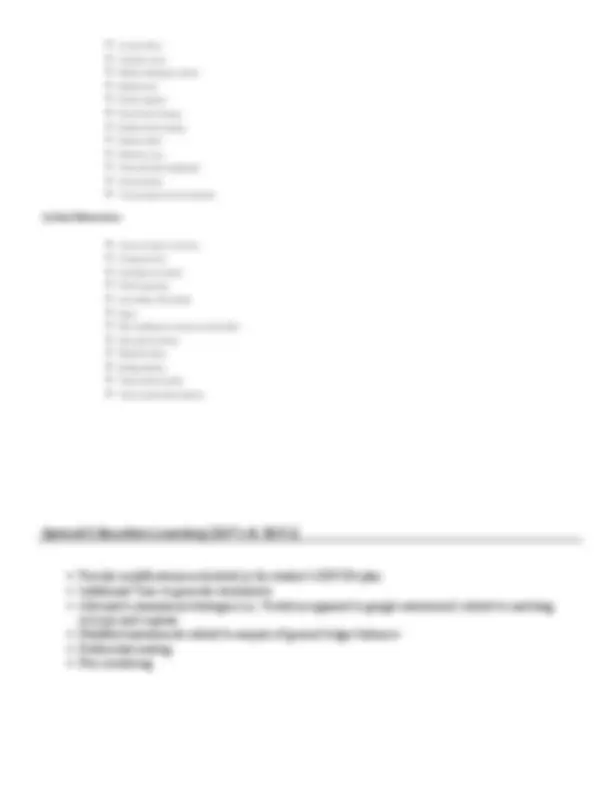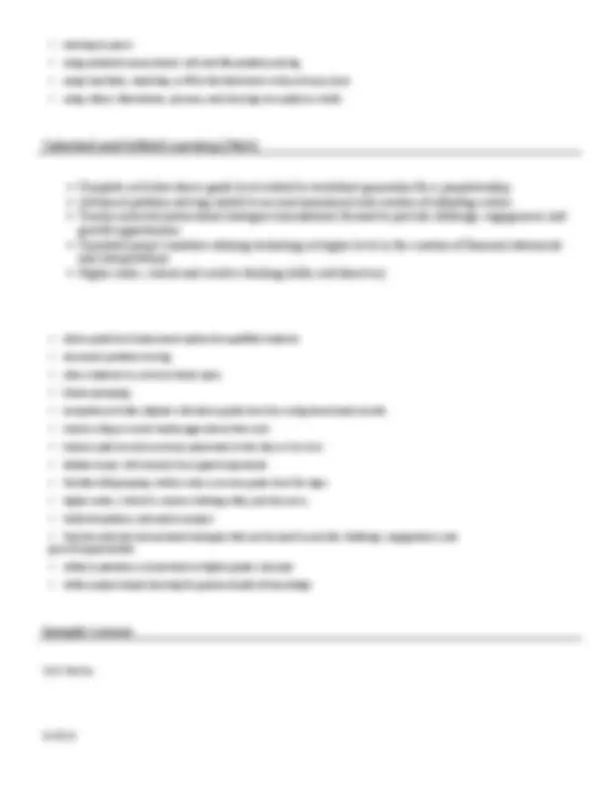Download ACCOUNTING 1, GRADES 9-12 Unit 5: Worksheet for a ... and more Lecture notes Accounting in PDF only on Docsity!
Unit 5 Worksheet for a Service Business
Content Area: 21st Century Life and Careers Course(s): Accounting 1 Time Period: Length: 27 Days Status: Published
Title Section
Department of Curriculum and Instruction
Belleville Public Schools
Curriculum Guide
ACCOUNTING 1, GRADES 9-
Unit 5: Worksheet for a Service Business
Belleville Board of Education
102 Passaic Avenue
Belleville, NJ 07109
Prepared by: Instructor, Loraine Gammaro
Dr. Richard Tomko, Ph.D., M.J., Superintendent of Schools
Ms. LucyAnn Demikoff, Director of Curriculum and Instruction K-
Ms. Nicole Shanklin, Director of Elementary Education K-8, ESL Coordinator K-
Mr. George Droste, Director of Secondary Education
Board Approved: September 23, 2019
Unit Overview
The theme for this unit is summarizing information on the general ledger which is needed to prepare financial
statements. Emphasis will be placed on summarizing account balances, proving debits and credits, updating
account balances, separation of ledger account balances according to financial statements to be prepared and
calculation of net income or loss over a fiscal period. Adjusting entries will also be introduced in this unit,
wherein the matching principle will be the focus. This theme is a prelude to future learning with respect to
financial statement preparation.
Enduring Understanding
Preparation of a worksheet is critical to the accounting process as it is the source for preparation of
financial statement for a business.
Students, throughout their lives should easily identify with terms and concepts related to a worksheet
for a service business proprietorship.
Understand which general ledger accounts are listed in a Trial Balance for a service proprietorship.
Understand how these concepts will apply with respect to pursuing a career in Entrepreneurship
New Jersey Student Learning Standards (NJSLS-S)
9.3.12.FN-ACT.4 Utilize career-planning concepts, tools and strategies to explore, obtain and/or develop an accounting career. PFL.9.1.12.A.6 Summarize the financial risks and benefits of entrepreneurship as a career choice. 9.3.12.FN-ACT.3 Process, evaluate and disseminate financial information to assist business decision making. 9.3.12.FN.2 Utilize tools, strategies and systems to plan, monitor, manage and maintain the use of financial resources. 9.3.12.FN.1 Utilize mathematical concepts, skills and problem solving to obtain necessary information for decision making in the finance industry. 9.3.12.FN-ACT.2 Utilize accounting tools, strategies and systems to plan, monitor, manage and maintain the use of financial resources. PFL.9.1.12.A.3 Analyze the relationship between various careers and personal earning goals. PFL.9.1.12.A.4 Identify a career goal and develop a plan and timetable for achieving it, including educational/training requirements, costs, and possible debt. 9.3.12.FN-ACT.1 Describe and follow laws and regulations to manage accounting operations and transactions. PFL.9.1.12.A.9 Analyze how personal and cultural values impact spending and other financial decisions.
Interdisciplinary Connections
LA.RST.11-12.5 Analyze how the text structures information or ideas into categories or hierarchies, demonstrating understanding of the information or ideas. LA.WHST.11-12.4 Produce clear and coherent writing in which the development, organization, and style are appropriate to task, purpose, and audience.
LA.WHST.11-12.5 Develop and strengthen writing as needed by planning, revising, editing, rewriting, or trying a new approach, focusing on addressing what is most significant for a specific purpose and audience. Functions Connections to Expressions, Equations, Modeling, and Coordinates. LA.RST.11-12.7 Integrate and evaluate multiple sources of information presented in diverse formats and media (e.g., quantitative data, video, multimedia) in order to address a question or solve a problem. LA.RST.11-12.9 Synthesize information from a range of sources (e.g., texts, experiments, simulations) into a coherent understanding of a process, phenomenon, or concept, resolving conflicting information when possible.
Learning Objectives
Students will be able to
Compose a heading and a trial balance on a worksheet
Assess and plan for adjustments to accounts in order to rectify errors
Generate a worksheet utilizing account balances within a general ledger for a service business
proprietorship
Measure the matching of revenue with expense over a fiscal period for a service business
proprietorship
Formulate responses to the four questions asked when analyzing worksheet adjustments
Action Verbs: Below are examples of action verbs associated with each level of the Revised Bloom's Taxonomy.
Remember Understand Apply Analyze Evaluate Create Choose Describe Define Label List Locate Match Memorize Name Omit Recite Select State Count Draw Outline Point Quote Recall Recognize Repeat Reproduce
Classify Defend Demonstrate Distinguish Explain Express Extend Give Examples Illustrate Indicate Interrelate Interpret Infer Match Paraphrase Represent Restate Rewrite Select Show Summarize Tell Translate Associate Compute Convert
Choose Dramatize Explain Generalize Judge Organize Paint Prepare Produce Select Show Sketch Solve Use Add Calculate Change Classify Complete Compute Discover Divide Examine Graph Interpolate Manipulate
Categorize Classify Compare Differentiate Distinguish Identify Infer Point out Select Subdivide Survey Arrange Breakdown Combine Detect Diagram Discriminate Illustrate Outline Point out Separate
Appraise Judge Criticize Defend Compare Assess Conclude Contrast Critique Determine Grade Justify Measure Rank Rate Support Test
Combine Compose Construct Design Develop Formulate Hypothesize Invent Make Originate Organize Plan Produce Role Play Drive Devise Generate Integrate Prescribe Propose Reconstruct Revise Rewrite Transform
presentational skills
Staff presentation of data via Google slides, Sheets YouTube, classroom for the purpose of establishing
forum for communication and to address all learning styles
Guided demonstration (model)
Assessment Evidence - Checking for Understanding (CFU)
GOOGLE: classroom communications, spreadsheets quizzes, surveys, anticipatory sets, exit tickets
(forms)-formative assessment
Quarterly benchmarks
Roundtable discussion results
Unit tests-summative assessment
Teacher observation
Rubrics
Web-based assessments-alternate assessment
-benchmark assessments (see below)
o Internet activities on utilization of account balances within a general ledger
o Student groups for the purpose of collaboration on accounting projects to assess and plan
adjustments to accounts
- Admit Tickets.
- Anticipation Guide.
- Common Benchmarks.
- Compare & Contrast.
- Create a Multimedia Poster.
- DBQ's.
- Define.
- Describe.
- Evaluate.
- Evaluation rubrics.
- Exit Tickets.
- Explaining.
- Fist- to-Five or Thumb-Ometer.
- Illustration.
- Journals.
- KWL Chart.
- Learning Center Activities.
- Multimedia Reports.
- Newspaper Headline.
- Outline.
- Question Stems.
- Quickwrite.
- Quizzes.
- Red Light, Green Light.
- Self- assessments.
- Socratic Seminar.
- Study Guide.
- Surveys.
- Teacher Observation Checklist.
- Think, Pair, Share.
- Think, Write, Pair, Share.
- Top 10 List.
- Unit review/Test prep.
- Unit tests.
- Web-Based Assessments.
- Written Reports.
Primary Resources & Materials
Gilbertson, C. South-Western century 21 accounting. 8th ed. Cincinnati, Ohio: South-Western.
Automated Accounting Software
Sheets: For the purpose of developing analytical skills
Docs: For the purpose of developing writing skills
CHROMEBOOKS/SMART TV
SOFTWARE SIMULATIONS
CRP.K-12.CRP10 Plan education and career paths aligned to personal goals. TECH.8.1.12.A.CS2 Select and use applications effectively and productively.
21st Century Skills/Interdisciplinary Themes
Creativity and Innovation
Critical Thinking and Problem Solving
Life and Career Skills
ICT (Information, Communications and Technology) Literacy
Communication and Collaboration
- Communication and Collaboration.
- Creativity and Innovation.
- Critical thinking and Problem Solving.
- ICT (Information, Communications and Technology) Literacy.
- Information Literacy.
- Life and Career Skills.
- Media Literacy.
21st Century Skills
Financial, Economic, business and Entrepreneurial Literacy
Global Awareness
- Civic Literacy.
- Environmental Literacy.
- Financial, Economic, Business and Entrepreneurial Literacy.
- Global Awareness.
- Health Literacy.
Differentiation
Small group instruction on assessment and planning of adjustments to accounts
Small group setting
Extra time to complete assignments (generation of a worksheet)
Pairing oral instructions with visuals related to matching revenue with expense
Study Guides
Preview content and concepts
Project based learning
Leveled rubrics
Open-ended activities
Choice of activities
Think Pair Share
Differentiations:
Small group instruction
Small group assignments
Extra time to complete assignments
Pairing oral instruction with visuals
Repeat directions
Use manipulatives
Center-based instruction
Token economy
Study guides
Teacher reads assessments allowed
Scheduled breaks
Rephrase written directions
Multisensory approaches
Additional time
Preview vocabulary
Preview content & concepts
Story guides
Behavior management plan
Highlight text
Student(s) work with assigned partner
Visual presentation
Assistive technology
Auditory presentations
Large print edition
Dictation to scribe
Small group setting
Hi-Prep Differentiations:
Alternative formative and summative assessments
Choice boards
Games and tournaments
Group investigations
Guided Reading
Independent research and projects
Interest groups
Learning contracts
- printed copy of board work/notes provided.
- additional time for skill mastery.
- assistive technology.
- behavior management plan.
- Center-Based Instruction.
- check work frequently for understanding.
- computer or electronic device utilizes.
- extended time on tests/ quizzes.
- have student repeat directions to check for understanding.
- highlighted text visual presentation.
- modified assignment format.
- modified test content.
- modified test format.
- modified test length.
- multiple test sessions.
- multi-sensory presentation.
- preferential seating.
- preview of content, concepts, and vocabulary.
- Provide modifications as dictated in the student's IEP/504 plan.
- reduced/shortened reading assignments.
- Reduced/shortened written assignments.
- secure attention before giving instruction/directions.
- shortened assignments.
- student working with an assigned partner.
- teacher initiated weekly assignment sheet.
- Use open book, study guides, test prototypes.
English Language Learning (ELL)
Translation of content/activities (Port of Entry) related to trial balance and worksheets
Assignments submitted in native language (Port of Entry)
Modifying assignments related to matching revenue with expense
Review assignment/project directions (model) utilization of account balances
Open book/notes options
Tutoring by peers
Modifying tests to reflect selected objectives
- teaching key aspects of a topic. Eliminate nonessential information.
- using videos, illustrations, pictures, and drawings to explain or clarif.
- allowing products (projects, timelines, demonstrations, models, drawings, dioramas, poster boards, charts, graphs, slide shows, videos, etc.) to demonstrate student’s learning;
- allowing students to correct errors (looking for understanding).
- allowing the use of note cards or open-book during testing.
- decreasing the amount of workpresented or required.
- having peers take notes or providing a copy of the teacher’s notes.
- modifying tests to reflect selected objectives.
- providing study guides.
- reducing or omitting lengthy outside reading assignments.
- reducing the number of answer choices on a multiple choice test.
- tutoring by peers.
- using computer word processing spell check and grammar check features.
- using true/false, matching, or fill in the blank tests in lieu of essay tests.
At Risk
Peer tutoring on worksheet generation
Correction and resubmission of work
Model concepts of worksheet components, revenue/expense matching
Evaluating correct work; collaborating with student on incorrect work
- allowing students to correct errors (looking for understanding).
- teaching key aspects of a topic. Eliminate nonessential information.
- allowing products (projects, timelines, demonstrations, models, drawings, dioramas, poster boards, charts, graphs, slide shows, videos, etc.) to demonstrate student’s learning
- allowing students to select from given choices.
- allowing the use of note cards or open-book during testing.
- collaborating (general education teacher and specialist) to modify vocabulary, omit or modify items to reflect objectives for the student, eliminate sections of the test, and determine how the grade will be determined prior to giving the test.
- decreasing the amount of workpresented or required.
- having peers take notes or providing a copy of the teacher’s notes.
- marking students’ correct and acceptable work, not the mistakes.
- modifying tests to reflect selected objectives.
- providing study guides.
- reducing or omitting lengthy outside reading assignments.
- reducing the number of answer choices on a multiple choice test.
Interdisciplinary Connection:
Statement of Objective:
Anticipatory Set/Do Now:
Learning Activity:
Student Assessment/CFU's:
Materials:
21st Century Themes and Skills:
Differentiation/Modifications:
Integration of Technology:

